UNITED STATES
SECURITIES AND EXCHANGE COMMISSION
Washington, D.C. 20549
FORM N-CSR
CERTIFIED SHAREHOLDER REPORT OF REGISTERED
MANAGEMENT INVESTMENT COMPANIES
Investment Company Act File Number: 811-08203
| T. Rowe Price Diversified Small-Cap Growth Fund, Inc. |
| (Exact name of registrant as specified in charter) |
| 100 East Pratt Street, Baltimore, MD 21202 |
| (Address of principal executive offices) |
| David Oestreicher |
| 100 East Pratt Street, Baltimore, MD 21202 |
| (Name and address of agent for service) |
Registrant’s telephone number, including area code: (410) 345-2000
Date of fiscal year end: December 31
Date of reporting period: June 30, 2014
Item 1. Report to Shareholders
 |
| Diversified Small-Cap Growth Fund | June 30, 2014 |

The views and opinions in this report were current as of June 30, 2014. They are not guarantees of performance or investment results and should not be taken as investment advice. Investment decisions reflect a variety of factors, and the managers reserve the right to change their views about individual stocks, sectors, and the markets at any time. As a result, the views expressed should not be relied upon as a forecast of the fund’s future investment intent. The report is certified under the Sarbanes-Oxley Act, which requires mutual funds and other public companies to affirm that, to the best of their knowledge, the information in their financial reports is fairly and accurately stated in all material respects.
REPORTS ON THE WEB
Sign up for our E-mail Program, and you can begin to receive updated fund reports and prospectuses online rather than through the mail. Log in to your account at troweprice.com for more information.
Manager’s Letter
Fellow Shareholders
Small-cap growth stocks produced positive returns in the first half of 2014. Falling long-term U.S. interest rates, corporate earnings growth, and new monetary stimulus measures in the eurozone were supportive, and investors remained optimistic in the face of several negative factors. These included a sharp first-quarter weather-related U.S. economic contraction, the Federal Reserve’s reduction of asset purchases, and early-year weakness among emerging markets assets and currencies due to expectations for reduced global liquidity. Heightened geopolitical tensions and U.S. and European Union sanctions against Russia for seizing Ukraine’s Crimean Peninsula were also a concern, but signs in the latter part of the period that Russia wants to de-escalate tensions with Ukraine were encouraging. In June, small-cap growth stocks surged as investors looked past rising oil prices due to sectarian violence in Iraq and anticipated stronger U.S. economic growth for the rest of the year.
PERFORMANCE COMPARISON
Your fund returned 2.64% in the first six months of 2014. As shown in the Performance Comparison table, the fund outperformed its Lipper peer group index but lagged the MSCI index.
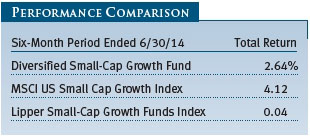
The fund’s relative performance versus the MSCI index was helped by good stock selection in the industrials and business services sector. However, our energy, information technology, and health care holdings under-performed their peers in the index, which limited our gains. As usual, the fund’s sector allocations—which mostly resemble those of the MSCI benchmark—had little aggregate impact on the fund’s relative results.
We are pleased to report that the fund’s longer-term record versus its peers is excellent. Lipper ranked the Diversified Small-Cap Growth Fund in the top 5% of the small-cap growth funds universe for the five-year period ended June 30, 2014, and in the top 12% for the 1-, 3-, and 10-year periods. Based on cumulative total return, Lipper ranked the fund 49 of 527, 48 of 466, 20 of 411, and 32 of 278 small-cap growth funds for the 1-, 3-, 5-, and 10-year periods ended June 30, 2014, respectively. (Results may vary for other periods. Past performance cannot guarantee future results.)
MARKET ENVIRONMENT
The U.S. economy has continued showing signs of sustaining moderate growth. While the first quarter had a larger-than-expected decline in gross domestic product, many indicators are signaling better economic performance in the second quarter. The growth in new jobs in June was over 280,000, which was a positive surprise. This reduced the unemployment rate to 6.1%. However, the labor participation rate, which has been declining since 2007, has still not picked up. The housing market is recovering, but home sales might be slowing down slightly due to higher mortgage rates relative to one year ago. The new head of the Federal Reserve, Janet Yellen, has indicated that the Fed’s current policy of low short-term interest rates will continue. However, the central bank’s monthly asset purchases will end in October. Despite the taper, the 10-year Treasury note yield at the end of June (2.53%) was lower than it was at the end of March (2.72%) and at the end of 2013 (3.03%).
In overseas markets, news from Europe is benign, which suggests there is moderate improvement in economic growth, as the eurozone continues to emerge from a protracted recession. Eurozone inflation is running well below 1%, and the European Central Bank (ECB) is implementing policies to counter low inflation, including very cheap four-year loans to banks to encourage lending and a negative deposit rate to discourage banks from keeping cash at the ECB. Developing markets as a group had a good second quarter, as many emerging markets currencies stabilized and markets recovered from earlier weakness and as investors embraced risk in the pursuit of higher returns.
Small-cap U.S. stocks lagged their large-cap peers in the first half of the year. The small-cap Russell 2000 Index returned 3.19% versus 7.27% for the large-cap Russell 1000 Index. Value stocks outperformed growth stocks across all market capitalizations.
While broad market volatility in recent months has been characterized as being historically low, it was a topsy-turvy market for the fastest-growing small-caps—especially biotechnology, Internet/social media, and software-as-a-service companies. These segments saw strong outperformance early in the year, significant underperformance in March and April, and a pickup in June. After our reporting period ended, there was another large drop in these high-expectation growth stocks in the first few days of July.
For the six-month period, sector performance in the small-cap growth universe, as measured by the MSCI US Small Cap Growth Index, varied widely. Energy stocks produced excellent returns, while materials, health care, and industrials and business services shares outperformed the index by narrower margins. Financials and information technology stocks edged higher, whereas consumer staples and consumer discretionary companies declined.
PORTFOLIO CHARACTERISTICS
The price fluctuations among small-cap growth stocks in the first half of the year underscore the value of having a diversified portfolio to blunt the volatility. While the fund’s recent gains are less than spectacular, we would remind our investors that our time horizon for investing is much longer than our reporting period, so it usually takes some time before our investments bear fruit. While the five-year bull market has lifted small-cap stock valuations—in some cases, to stretched levels—we believe it is as important as ever to remain committed to the strategy and investment process that have served our investors well over time. We believe these will help us navigate through the years ahead and continue rewarding patient investors with long-term capital growth:
We favor companies that have a high return on capital and use cash flows wisely in a manner that benefits shareholders. We prefer companies that generate substantial free cash flow.
We seek companies with good earnings quality and sustainable growth characteristics.
We look for companies with attractive valuations relative to other firms in the same industry and relative to the small-cap growth universe as a whole. We like companies with reasonable valuations relative to their earnings and sales growth rates. In fact, we believe that the fastest growing and most expensive companies tend to underperform over time because their valuations often get driven to unsustainable levels.
While stock selection is based on a quantitative model, we do take into consideration the fundamental research done by T. Rowe Price’s equity analysts. Given the unusual economic environment, we are also taking macroeconomic conditions into account.
The fund’s sector allocations are usually very similar to those of the MSCI US Small Cap Growth Index, as shown in the Sector Diversification table on page 6, but the portfolio may occasionally have small overweights or underweights. As of June 30, we had a notable overweight in health care, as well as an underweight in materials following a benchmark rebalancing at the end of May that lifted the MSCI index’s materials weighting. We have purchased some materials stocks to narrow the gap.
Our strategy is to try to outperform our benchmark by owning a large number of good stocks instead of making large investments in a small number of stocks. The portfolio currently holds about 290 names, and very few of our largest positions represent 1.0% or more of the fund’s net assets at any given time. This level of diversification should help manage the risk of investing in small-cap growth stocks. Our goal is to provide steady outperformance over time with lower risk than that of the small-cap market. We believe mitigating downside risk in rising markets and preventing losses in down markets can help relative performance over time.
Cash reserves are a drag on long-term performance in a rising market, so we try to keep our cash position low and deploy cash flows quickly to stay fully invested. Trading is another cost that reduces returns, so we trade electronically and in low-cost venues when possible. The fund tends to have a fairly low annual turnover rate because our time horizon is longer than that of other small-cap growth portfolios.
Our portfolio turnover rate in the one-year period ended June 30, 2014, was 15.6%, which is substantially less than the 2013 average of 80.32% for small-cap growth funds, according to data from Morningstar Direct. (Morningstar only calculates portfolio turnover for its averages at year-end, using the most recent year-end portfolio turnover figures provided to Morningstar by each of the underlying funds in the average. The Morningstar data were quoted as of July 16, 2014.) This implies that our holding period for a typical stock is a little more than six years, whereas our average competitor holds a given stock for a little more than one year.
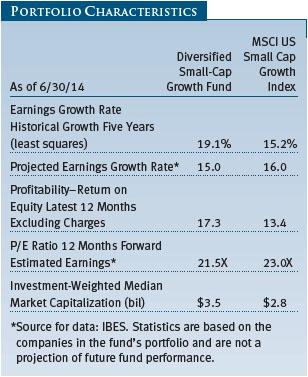
PORTFOLIO REVIEW
Industrials and business services stocks contributed the most to the fund’s absolute performance in the first half of 2014. Road and rail stocks led the way, with vehicle rental company Avis Budget Group producing excellent returns. Most of our machinery stocks did well, especially Wabtec, a high-quality industrial company that makes and services railroad and transit equipment. Its train control software is being widely implemented as safety becomes of increasing concern following several visible rail accidents. Spirit Airlines, a low-cost airline serving North and South America, and Acuity Brands, which produces commercial light fixtures and lighting systems and is concentrating more on energy efficiency, were also outstanding performers. Aerospace and defense stocks and providers of professional services generally trailed, with a few exceptions. (Please refer to the fund’s portfolio of investments for a complete list of holdings and the amount each represents in the portfolio.)
Health care stocks made a solid contribution to the fund’s absolute performance. Pharmaceuticals outpaced other health care industries, led by Questcor Pharmaceuticals and Salix Pharmaceuticals. In the life sciences tools and services segment, Illumina produced excellent returns. The company reported better-than-expected first-quarter financial results and raised its earnings and revenue guidance for the year. Our equipment and supply companies were widely mixed but produced gains in aggregate. Biotechnology stocks were among our largest detractors in the entire portfolio, but one major exception was Idenix Pharmaceuticals, which agreed to be acquired by Merck. Another was InterMune, which surged amid hopes that its drug to treat fibrosis in the lungs—which is available in some foreign countries—could soon be available in the U.S. Shortly after our reporting period ended, the Food and Drug Administration (FDA) gave the drug a “breakthrough therapy” designation, which could expedite the FDA’s review and approval process.
Although the energy sector is a fairly small part of the small-cap growth universe, our holdings produced strong returns. Many of our oil and gas companies performed very well, especially exploration and production (E&P) company Diamondback Energy, which we added to the fund in the first half of the year, and Clayton Williams Energy, which reported strong earnings due to its profitable holdings in the Delaware/Permian Basin. There was also some speculation that the company could be an attractive takeover target or decide to sell its Permian interest. Our equipment and services companies were mixed, with Core Laboratories among the laggards. The company analyzes rock and fluid samples from oil and gas wells to help E&P companies understand what they have and how to get more of it out of the ground, but shares have weakened as slowing capital expenditures in the industry have hurt the company’s revenues.
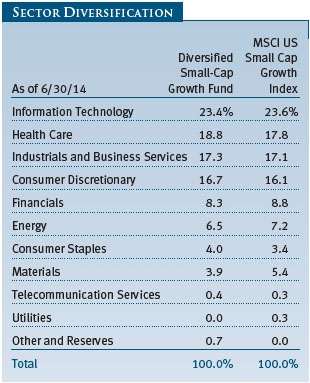
Information technology stocks as a group made a slight contribution to fund performance, as strength in our semiconductor-related holdings—especially Synaptics and Cavium—was largely offset by poor results in other tech industries. In the software segment, Commvault Systems was a major detractor; in IT services, Heartland Payment Systems and CoreLogic were poor performers. Payments processor Heartland declined in the first half of 2014 amid concerns about its valuation following stellar gains last year, while data and analytics company CoreLogic was hurt by a significant slowdown in mortgage origination activity and a disappointing first-quarter earnings report. One of the worst performers in the entire portfolio was 3D Systems. While the company remains dominant in three-dimensional printing—and was a big winner for us last year—shares fell sharply amid concerns about its valuation and profit margin pressures.
Financial stocks generally detracted from our results in the first half of 2014. Our diversified financial services companies fared worst, with options exchange CBOE Holdings struggling amid low market volatility. Several of our capital markets companies also sagged, including Financial Engines, a new portfolio holding that uses proprietary technology to provide independent investment advice and planning services to 401(k) plan participants. We believe that the company’s innovative business model for financial planning in retirement plans will allow it to grow and thrive over time. Real estate investment trusts (REITs), which tend to have attractive yields, performed best for us in the sector, helped by falling long-term interest rates. However, we only own a few because REITs are generally not cheap and will be hurt if rates rise.
Consumer discretionary stocks detracted the most from fund performance in the first six months of 2014, as the first-quarter economic contraction and a tough consumer environment weighed on the sector. Most of our specialty retailers fell sharply, especially shoe-seller DSW. Boat maker Brunswick and snowmobile maker Polaris Industries were also weak. On the plus side, apparel maker Hanesbrands produced excellent gains and was our top contributor to fund performance. The company surpassed first-quarter earnings expectations and raised its earnings guidance for 2014, and we believe it can grow at a steady rate over the next few years. Most of our media companies produced mediocre returns, but Live Nation Entertainment performed well. The company owns or operates various venues for music and other live entertainment, and shares rose in part because of a favorable first-quarter financial report. Also, Liberty Media increased its stake in the company.
OUTLOOK
Small-cap growth stocks have performed very well over the last five years, but given the small-cap valuation premium versus large-cap stocks, we believe investors should temper their performance expectations in the period ahead. There are some signs of excess and high-risk behavior in parts of the capital markets, which should encourage investors to embrace a healthy dose of caution. For example, initial public offerings (IPOs) and merger and acquisition (M&A) activity have been increasing, and the quality of companies going public has been deteriorating. Also, given the significant appreciation we’ve seen in recent years, we are finding it somewhat more difficult to find small growth companies with attractive attributes and reasonable valuations. The volatility among high-expectation stocks could indicate that valuations have reached or are approaching unsustainable levels—yet some investors are “chasing performance” and flocking to “momentum” stocks that have already done very well for some time. In addition, the Federal Reserve’s tapering of asset purchases is clearly a sign that the central bank is becoming less accommodative, albeit incrementally, and that interest rates will eventually rise.
At a recent meeting at the International Monetary Fund (IMF), Fed Chair Janet Yellen suggested that high-risk behavior in certain segments of the market could be dealt with through macroprudential policy changes, such as increased “regulatory limits on leverage and short-term funding,” rather than through raising interest rates. To the extent the Fed can deal with issues in capital market segments without raising rates, it should allow the central bank to keep rates low for longer, which would support stock returns. Still, it would not be prudent for investors to become complacent with a market that has generated strong returns—and has been supported by low interest rates—for several years without a significant downturn.
The investment landscape is constantly changing, but our investment strategy remains the same. While we take macroeconomic events into account in the course of monitoring portfolio risks, having neutral sector weights versus our benchmark helps us avoid risks due to large moves in any one sector—which we certainly saw at times over the last six months. We continue to favor high-quality stocks of companies that generate good cash flows and are judicious in deploying capital. We believe that such companies will distinguish themselves over time with superior performance relative to lower-quality businesses.
We are grateful for the confidence that our shareholders have in our investment management abilities.
Respectfully submitted,

Sudhir Nanda
Chairman of the fund’s Investment Advisory Committee
July 28, 2014
The committee chairman has day-to-day responsibility for managing the portfolio and works with committee members in developing and executing the fund’s investment program.
RISKS OF INVESTING
As with all stock mutual funds, the fund’s share price can fall because of weakness in the stock market, a particular industry, or specific holdings. Stock markets can decline for many reasons, including adverse political or economic developments, changes in investor psychology, or heavy institutional selling. The prospects for an industry or company may deteriorate because of a variety of factors, including disappointing earnings or changes in the competitive environment. In addition, the investment manager’s assessment of companies held in a fund may prove incorrect, resulting in losses or poor performance even in rising markets.
Growth stocks can be volatile for several reasons. Since these companies usually invest a high portion of earnings in their businesses, they may lack the dividends of value stocks that can cushion stock prices in a falling market. Also, earnings disappointments often lead to sharply falling prices because investors buy growth stocks in anticipation of superior earnings growth.
Investing in small companies involves greater risk than is customarily associated with larger companies. Stocks of smaller companies are subject to more abrupt or erratic price movements than larger-company stocks. Small companies often have limited product lines, markets, or financial resources, and their managements may lack depth and experience. Such companies seldom pay significant dividends that could cushion returns in a falling market.
GLOSSARY
Earnings growth rate–current fiscal year: Measures the annualized percent change in earnings per share from the prior fiscal year to the current fiscal year.
Lipper indexes: Fund benchmarks that consist of a small number (10 to 30) of the largest mutual funds in a particular category as defined by Lipper Inc.
MSCI US Small Cap Growth Index: Tracks the performance of domestic small-cap growth stocks as defined by MSCI.
Price-to-earnings (P/E) ratio–12 months forward: A valuation measure calculated by dividing the price of a stock by the analysts’ forecast of the next 12 months’ expected earnings. The ratio is a measure of how much investors are willing to pay for the company’s future earnings. The higher the P/E, the more investors are paying for a company’s earnings growth in the next 12 months.
Projected earnings growth rate (IBES): A company’s expected earnings per share growth rate for a given time period based on the forecast from the Institutional Brokers’ Estimate System, which is commonly referred to as IBES.
Return on equity (ROE)–current fiscal year: A valuation measure calculated by dividing the company’s current fiscal year net income by shareholders’ equity (i.e., the company’s book value). ROE measures how much a company earns on each dollar that common stock investors have put into the company. It indicates how effectively and efficiently a company and its management are using stockholder investments.
Russell 1000 Index: An index that tracks the performance of the 1,000 largest companies in the Russell 3000 Index.
Russell 2000 Growth Index: An index that tracks the performance of small-cap stocks with higher price-to-book ratios and higher forecast growth values.
Russell 2000 Index: An unmanaged index that tracks the stocks of 2,000 small U.S. companies.
Russell 2000 Value Index: An index that tracks the performance of small-cap stocks with lower price-to-book ratios and lower forecast growth values.
S&P 500 Index: An unmanaged index that tracks the stocks of 500 primarily large U.S. companies.
Note: MSCI makes no express or implied warranties or representations and shall have no liability whatsoever with respect to any MSCI data contained herein. The MSCI data may not be further redistributed or used as a basis for other indices or any securities or financial products. This report is not approved, reviewed, or produced by MSCI.
Note: Russell Investment Group is the source and owner of the trademarks, service marks, and copyrights related to the Russell indexes. Russell® is a trademark of Russell Investment Group.
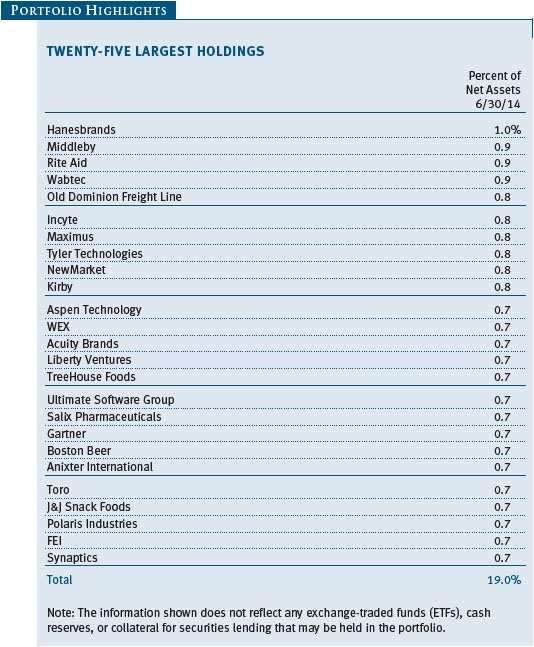
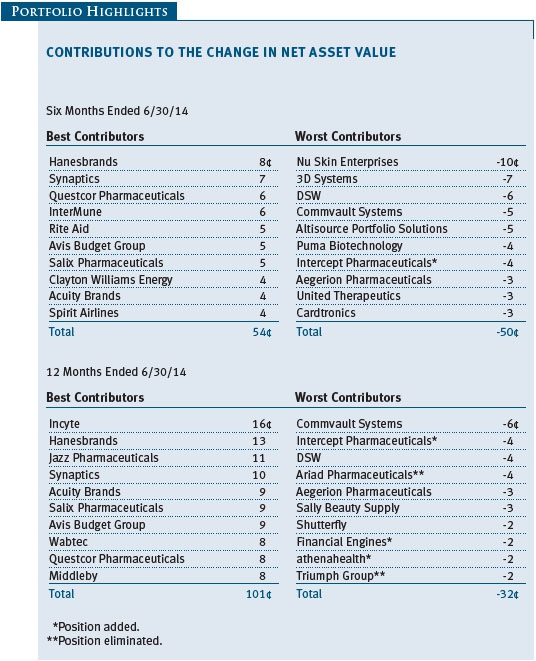
Performance and Expenses
| Growth of $10,000 |
This chart shows the value of a hypothetical $10,000 investment in the fund over the past 10 fiscal year periods or since inception (for funds lacking 10-year records). The result is compared with benchmarks, which may include a broad-based market index and a peer group average or index. Market indexes do not include expenses, which are deducted from fund returns as well as mutual fund averages and indexes.
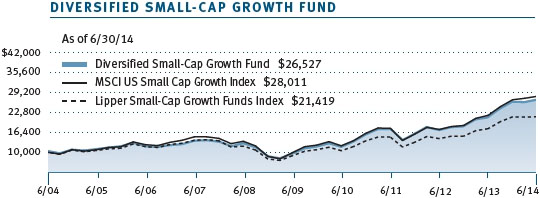
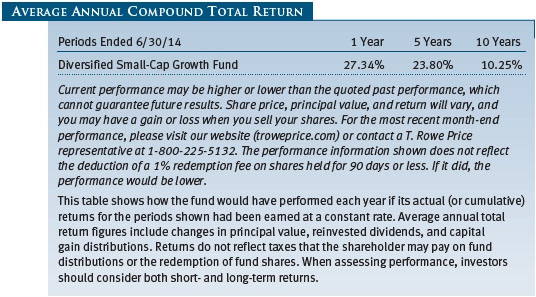

| Fund Expense Example |
As a mutual fund shareholder, you may incur two types of costs: (1) transaction costs, such as redemption fees or sales loads, and (2) ongoing costs, including management fees, distribution and service (12b-1) fees, and other fund expenses. The following example is intended to help you understand your ongoing costs (in dollars) of investing in the fund and to compare these costs with the ongoing costs of investing in other mutual funds. The example is based on an investment of $1,000 invested at the beginning of the most recent six-month period and held for the entire period.
Actual Expenses
The first line of the following table (Actual) provides information about actual account values and expenses based on the fund’s actual returns. You may use the information on this line, together with your account balance, to estimate the expenses that you paid over the period. Simply divide your account value by $1,000 (for example, an $8,600 account value divided by $1,000 = 8.6), then multiply the result by the number on the first line under the heading “Expenses Paid During Period” to estimate the expenses you paid on your account during this period.
Hypothetical Example for Comparison Purposes
The information on the second line of the table (Hypothetical) is based on hypothetical account values and expenses derived from the fund’s actual expense ratio and an assumed 5% per year rate of return before expenses (not the fund’s actual return). You may compare the ongoing costs of investing in the fund with other funds by contrasting this 5% hypothetical example and the 5% hypothetical examples that appear in the shareholder reports of the other funds. The hypothetical account values and expenses may not be used to estimate the actual ending account balance or expenses you paid for the period.
Note: T. Rowe Price charges an annual account service fee of $20, generally for accounts with less than $10,000. The fee is waived for any investor whose T. Rowe Price mutual fund accounts total $50,000 or more; accounts electing to receive electronic delivery of account statements, transaction confirmations, prospectuses, and shareholder reports; or accounts of an investor who is a T. Rowe Price Preferred Services, Personal Services, or Enhanced Personal Services client (enrollment in these programs generally requires T. Rowe Price assets of at least $100,000). This fee is not included in the accompanying table. If you are subject to the fee, keep it in mind when you are estimating the ongoing expenses of investing in the fund and when comparing the expenses of this fund with other funds.
You should also be aware that the expenses shown in the table highlight only your ongoing costs and do not reflect any transaction costs, such as redemption fees or sales loads. Therefore, the second line of the table is useful in comparing ongoing costs only and will not help you determine the relative total costs of owning different funds. To the extent a fund charges transaction costs, however, the total cost of owning that fund is higher.
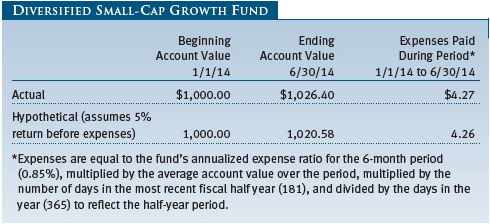
Unaudited
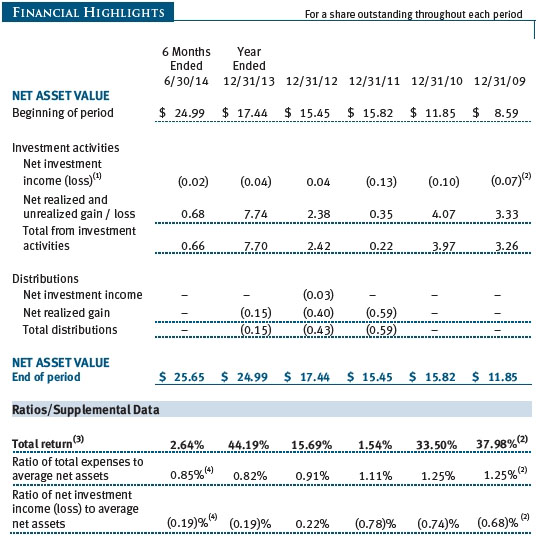
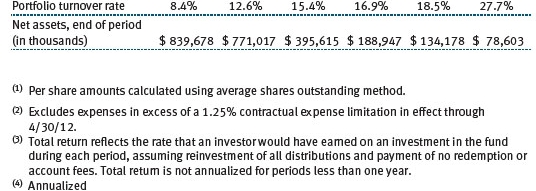
The accompanying notes are an integral part of these financial statements.
Unaudited
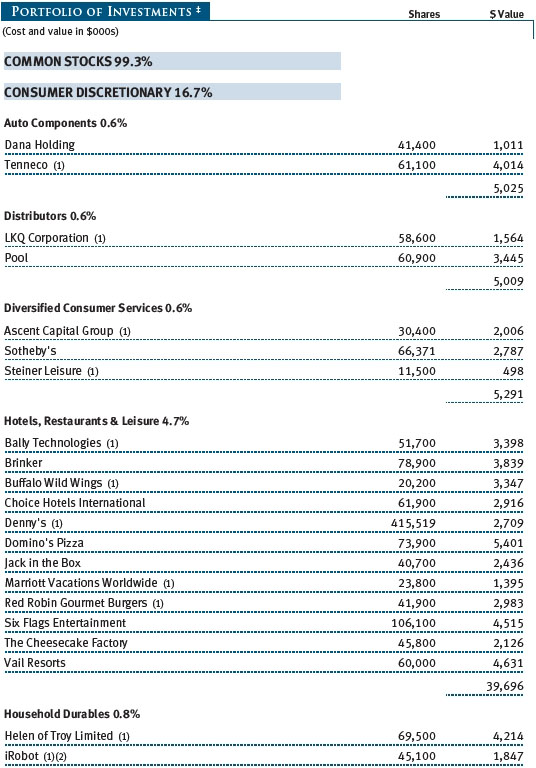
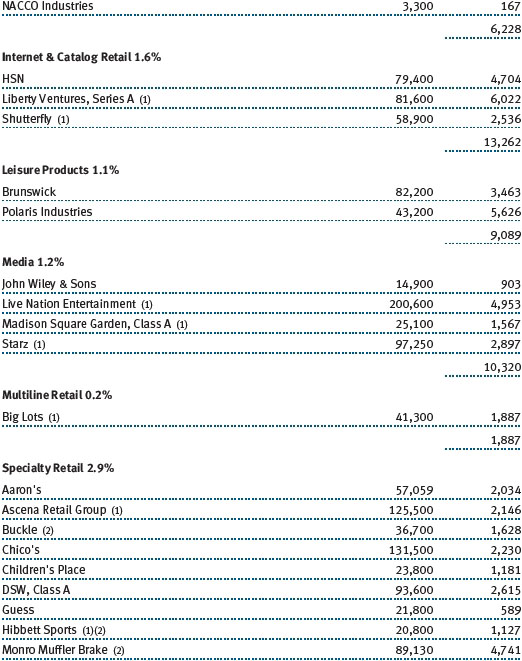
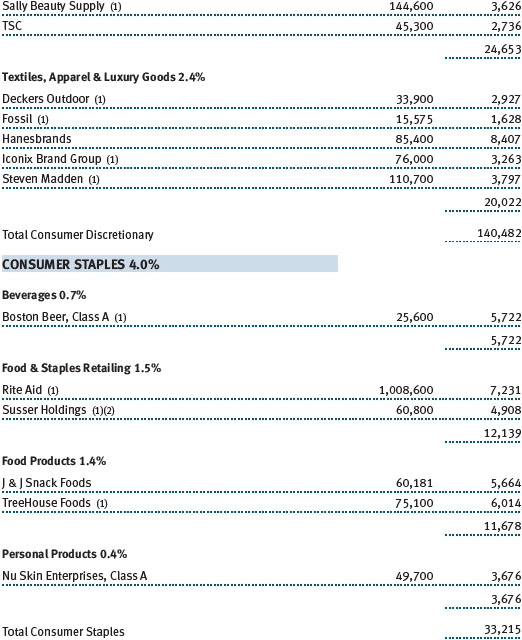
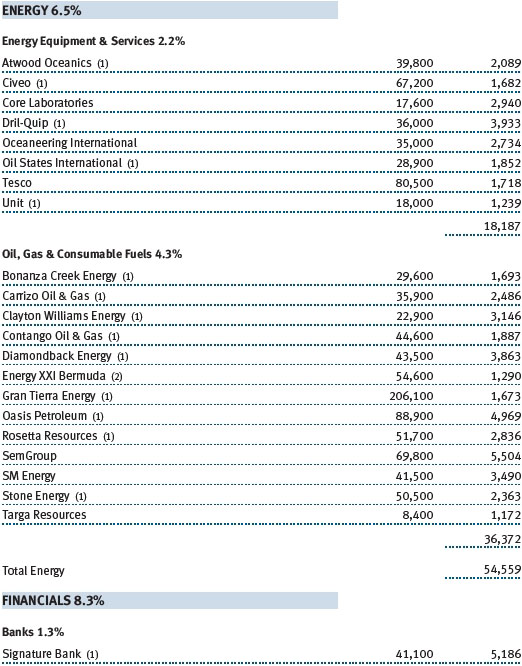
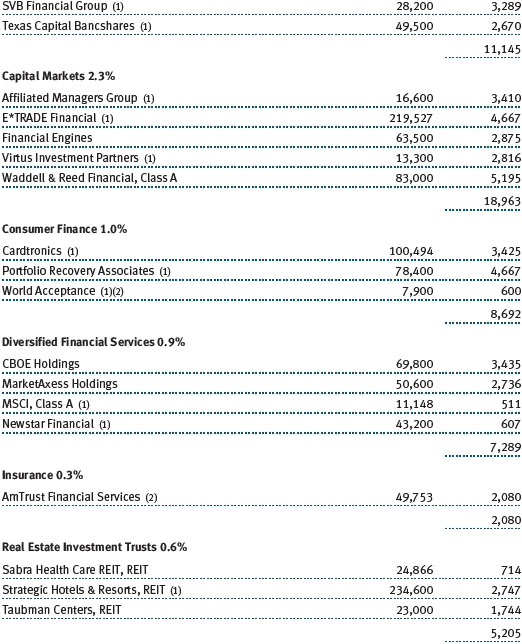
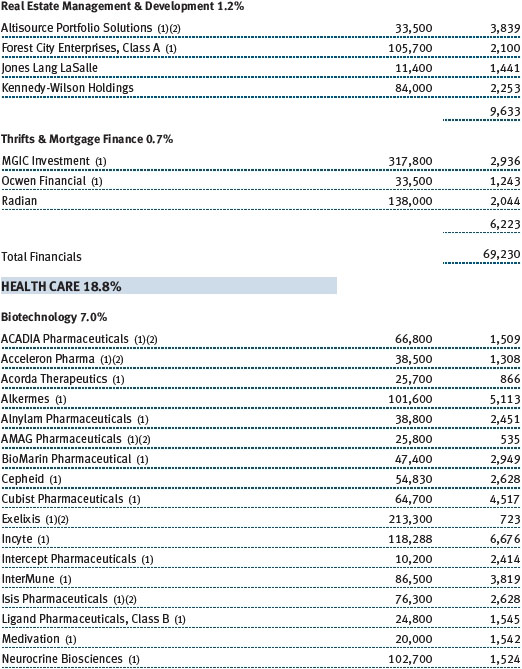
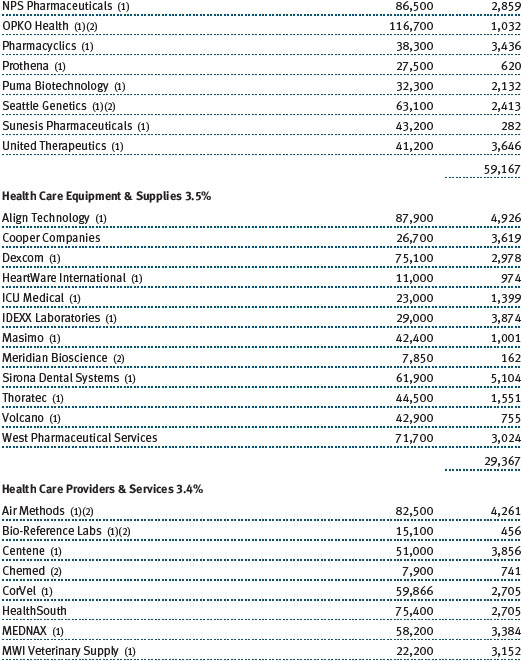
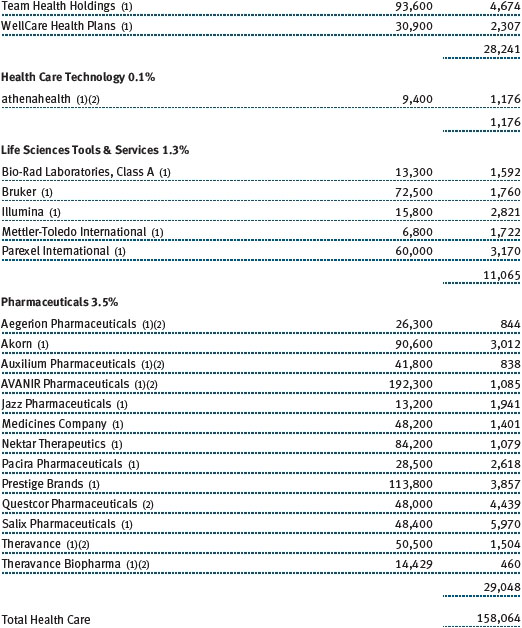
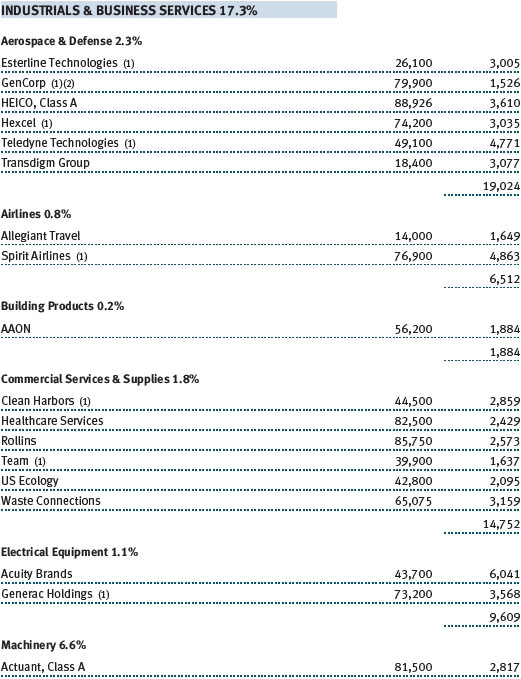
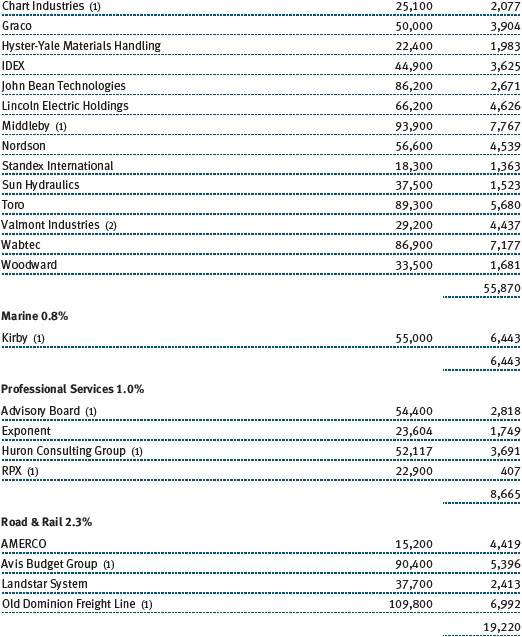
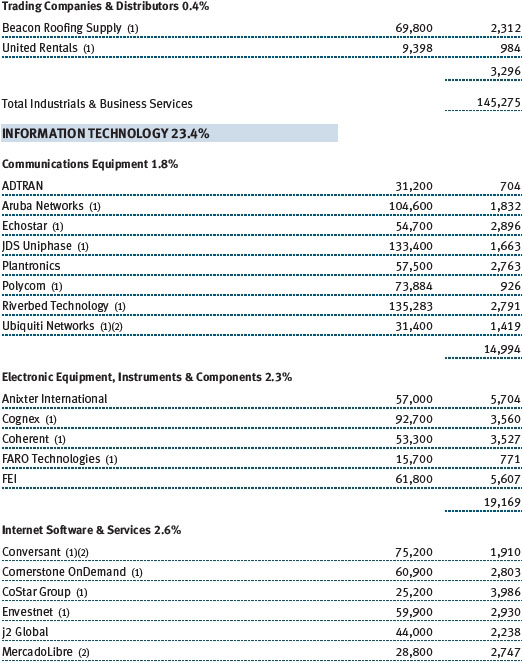
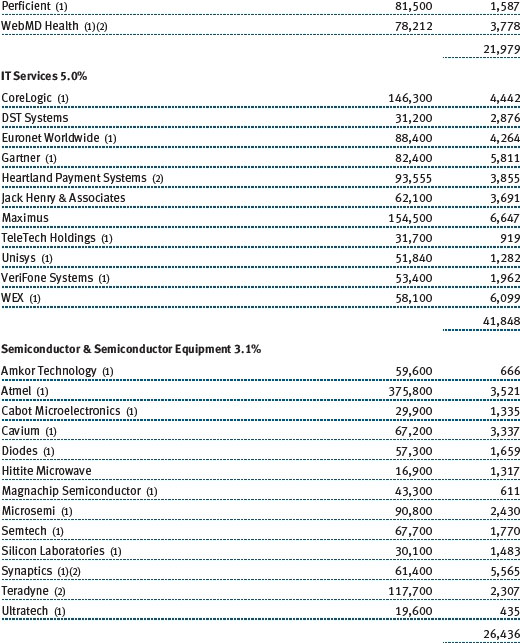
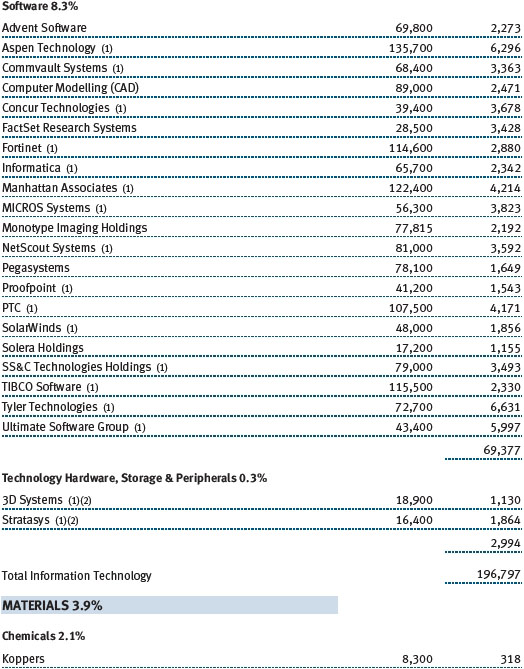
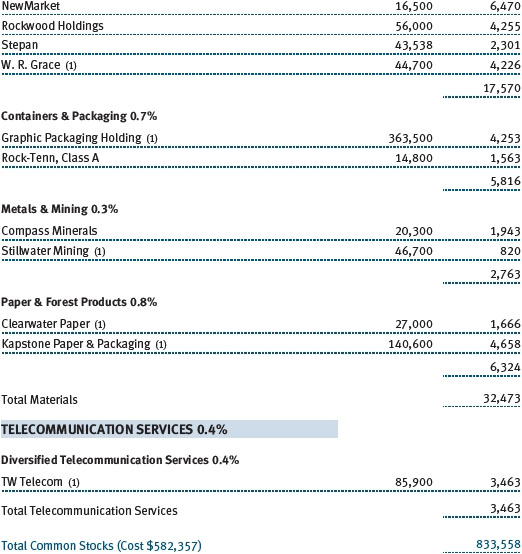

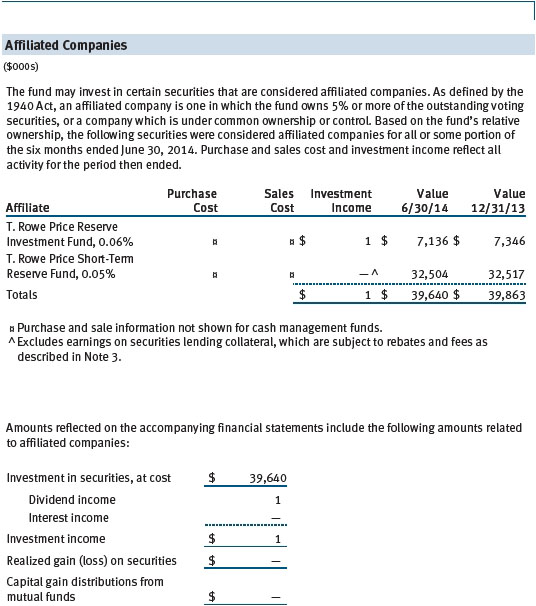
The accompanying notes are an integral part of these financial statements.
Unaudited
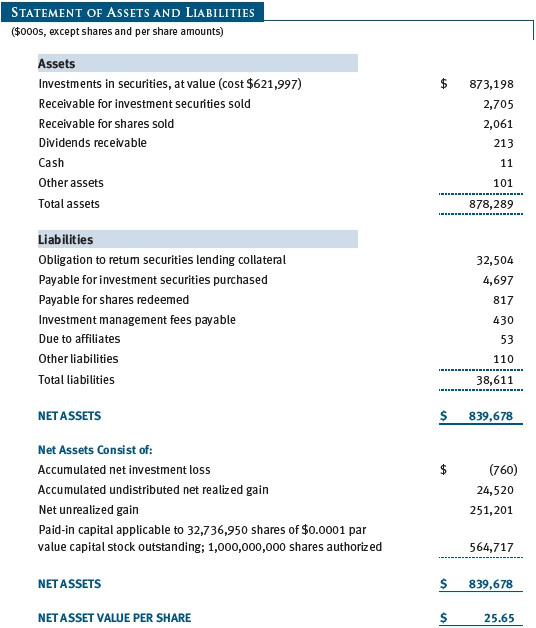
The accompanying notes are an integral part of these financial statements.
Unaudited
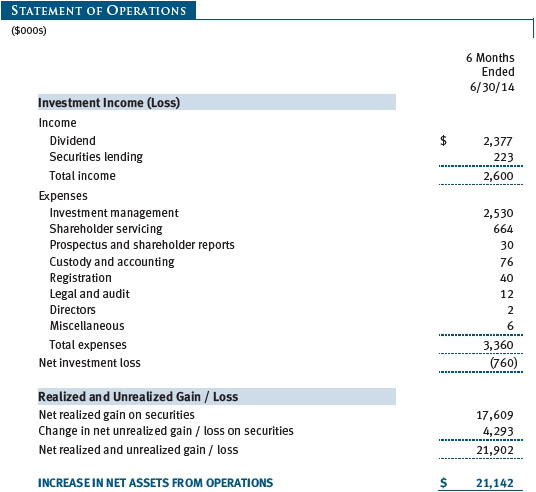
The accompanying notes are an integral part of these financial statements.
Unaudited
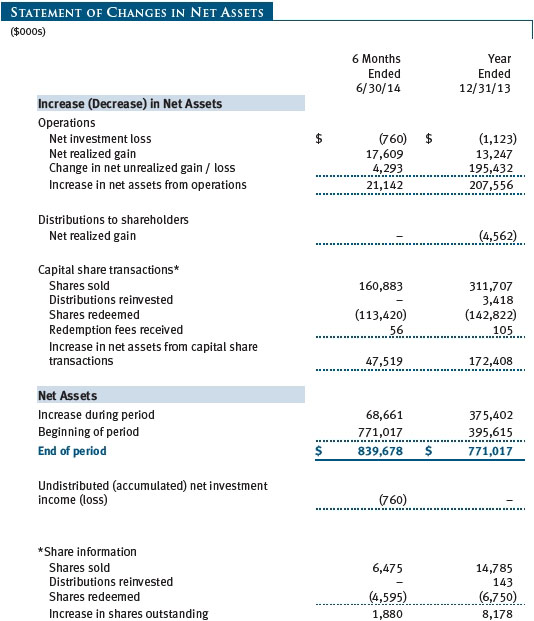
The accompanying notes are an integral part of these financial statements.
Unaudited
| Notes to Financial Statements |
T. Rowe Price Diversified Small-Cap Growth Fund, Inc. (the fund), is registered under the Investment Company Act of 1940 (the 1940 Act) as a diversified, open-end management investment company. The fund commenced operations on June 30, 1997. The fund seeks long-term growth of capital by investing primarily in common stocks of small growth companies.
NOTE 1 - SIGNIFICANT ACCOUNTING POLICIES
Basis of Preparation The fund is an investment company and follows accounting and reporting guidance in the Financial Accounting Standards Board Accounting Standards Codification Topic 946 (ASC 946). The accompanying financial statements were prepared in accordance with accounting principles generally accepted in the United States of America (GAAP), including but not limited to ASC 946. GAAP requires the use of estimates made by management. Management believes that estimates and valuations are appropriate; however, actual results may differ from those estimates, and the valuations reflected in the accompanying financial statements may differ from the value ultimately realized upon sale or maturity.
Investment Transactions, Investment Income, and Distributions Income and expenses are recorded on the accrual basis. Dividends received from mutual fund investments are reflected as dividend income; capital gain distributions are reflected as realized gain/loss. Dividend income and capital gain distributions are recorded on the ex-dividend date. Income tax-related interest and penalties, if incurred, would be recorded as income tax expense. Investment transactions are accounted for on the trade date. Realized gains and losses are reported on the identified cost basis. Distributions to shareholders are recorded on the ex-dividend date. Income distributions are declared and paid annually. Capital gain distributions, if any, are generally declared and paid by the fund annually.
Currency Translation Assets, including investments, and liabilities denominated in foreign currencies are translated into U.S. dollar values each day at the prevailing exchange rate, using the mean of the bid and asked prices of such currencies against U.S. dollars as quoted by a major bank. Purchases and sales of securities, income, and expenses are translated into U.S. dollars at the prevailing exchange rate on the date of the transaction. The effect of changes in foreign currency exchange rates on realized and unrealized security gains and losses is reflected as a component of security gains and losses.
Rebates Subject to best execution, the fund may direct certain security trades to brokers who have agreed to rebate a portion of the related brokerage commission to the fund in cash. Commission rebates are reflected as realized gain on securities in the accompanying financial statements and totaled $2,000 for the six months ended June 30, 2014.
Redemption Fees A 1% fee is assessed on redemptions of fund shares held for 90 days or less to deter short-term trading and to protect the interests of long-term shareholders. Redemption fees are withheld from proceeds that shareholders receive from the sale or exchange of fund shares. The fees are paid to the fund and are recorded as an increase to paid-in capital. The fees may cause the redemption price per share to differ from the net asset value per share.
NOTE 2 - VALUATION
The fund’s financial instruments are valued and its net asset value (NAV) per share is computed at the close of the New York Stock Exchange (NYSE), normally 4 p.m. ET, each day the NYSE is open for business.
Fair Value The fund’s financial instruments are reported at fair value, which GAAP defines as the price that would be received to sell an asset or paid to transfer a liability in an orderly transaction between market participants at the measurement date. The T. Rowe Price Valuation Committee (the Valuation Committee) has been established by the fund’s Board of Directors (the Board) to ensure that financial instruments are appropriately priced at fair value in accordance with GAAP and the 1940 Act. Subject to oversight by the Board, the Valuation Committee develops and oversees pricing-related policies and procedures and approves all fair value determinations. Specifically, the Valuation Committee establishes procedures to value securities; determines pricing techniques, sources, and persons eligible to effect fair value pricing actions; oversees the selection, services, and performance of pricing vendors; oversees valuation-related business continuity practices; and provides guidance on internal controls and valuation-related matters. The Valuation Committee reports to the fund’s Board; is chaired by the fund’s treasurer; and has representation from legal, portfolio management and trading, operations, and risk management.
Various valuation techniques and inputs are used to determine the fair value of financial instruments. GAAP establishes the following fair value hierarchy that categorizes the inputs used to measure fair value:
Level 1 – quoted prices (unadjusted) in active markets for identical financial instruments that the fund can access at the reporting date
Level 2 – inputs other than Level 1 quoted prices that are observable, either directly or indirectly (including, but not limited to, quoted prices for similar financial instruments in active markets, quoted prices for identical or similar financial instruments in inactive markets, interest rates and yield curves, implied volatilities, and credit spreads)
Level 3 – unobservable inputs
Observable inputs are developed using market data, such as publicly available information about actual events or transactions, and reflect the assumptions that market participants would use to price the financial instrument. Unobservable inputs are those for which market data are not available and are developed using the best information available about the assumptions that market participants would use to price the financial instrument. GAAP requires valuation techniques to maximize the use of relevant observable inputs and minimize the use of unobservable inputs. When multiple inputs are used to derive fair value, the financial instrument is assigned to the level within the fair value hierarchy based on the lowest-level input that is significant to the fair value of the financial instrument. Input levels are not necessarily an indication of the risk or liquidity associated with financial instruments at that level but rather the degree of judgment used in determining those values.
Valuation Techniques Equity securities listed or regularly traded on a securities exchange or in the over-the-counter (OTC) market are valued at the last quoted sale price or, for certain markets, the official closing price at the time the valuations are made. OTC Bulletin Board securities are valued at the mean of the closing bid and asked prices. A security that is listed or traded on more than one exchange is valued at the quotation on the exchange determined to be the primary market for such security. Listed securities not traded on a particular day are valued at the mean of the closing bid and asked prices for domestic securities and the last quoted sale or closing price for international securities.
For valuation purposes, the last quoted prices of non-U.S. equity securities may be adjusted to reflect the fair value of such securities at the close of the NYSE. If the fund determines that developments between the close of a foreign market and the close of the NYSE will, in its judgment, materially affect the value of some or all of its portfolio securities, the fund will adjust the previous quoted prices to reflect what it believes to be the fair value of the securities as of the close of the NYSE. In deciding whether it is necessary to adjust quoted prices to reflect fair value, the fund reviews a variety of factors, including developments in foreign markets, the performance of U.S. securities markets, and the performance of instruments trading in U.S. markets that represent foreign securities and baskets of foreign securities. The fund may also fair value securities in other situations, such as when a particular foreign market is closed but the fund is open. The fund uses outside pricing services to provide it with quoted prices and information to evaluate or adjust those prices. The fund cannot predict how often it will use quoted prices and how often it will determine it necessary to adjust those prices to reflect fair value. As a means of evaluating its security valuation process, the fund routinely compares quoted prices, the next day’s opening prices in the same markets, and adjusted prices.
Actively traded domestic equity securities generally are categorized in Level 1 of the fair value hierarchy. Non-U.S. equity securities generally are categorized in Level 2 of the fair value hierarchy despite the availability of quoted prices because, as described above, the fund evaluates and determines whether those quoted prices reflect fair value at the close of the NYSE or require adjustment. OTC Bulletin Board securities, certain preferred securities, and equity securities traded in inactive markets generally are categorized in Level 2 of the fair value hierarchy.
Investments in mutual funds are valued at the mutual fund’s closing NAV per share on the day of valuation and are categorized in Level 1 of the fair value hierarchy. Assets and liabilities other than financial instruments, including short-term receivables and payables, are carried at cost, or estimated realizable value, if less, which approximates fair value.
Thinly traded financial instruments and those for which the above valuation procedures are inappropriate or are deemed not to reflect fair value are stated at fair value as determined in good faith by the Valuation Committee. The objective of any fair value pricing determination is to arrive at a price that could reasonably be expected from a current sale. Financial instruments fair valued by the Valuation Committee are primarily private placements, restricted securities, warrants, rights, and other securities that are not publicly traded.
Subject to oversight by the Board, the Valuation Committee regularly makes good faith judgments to establish and adjust the fair valuations of certain securities as events occur and circumstances warrant. For instance, in determining the fair value of an equity investment with limited market activity, such as a private placement or a thinly traded public company stock, the Valuation Committee considers a variety of factors, which may include, but are not limited to, the issuer’s business prospects, its financial standing and performance, recent investment transactions in the issuer, new rounds of financing, negotiated transactions of significant size between other investors in the company, relevant market valuations of peer companies, strategic events affecting the company, market liquidity for the issuer, and general economic conditions and events. In consultation with the investment and pricing teams, the Valuation Committee will determine an appropriate valuation technique based on available information, which may include both observable and unobservable inputs. The Valuation Committee typically will afford greatest weight to actual prices in arm’s length transactions, to the extent they represent orderly transactions between market participants; transaction information can be reliably obtained; and prices are deemed representative of fair value. However, the Valuation Committee may also consider other valuation methods such as market-based valuation multiples; a discount or premium from market value of a similar, freely traded security of the same issuer; or some combination. Fair value determinations are reviewed on a regular basis and updated as information becomes available, including actual purchase and sale transactions of the issue. Because any fair value determination involves a significant amount of judgment, there is a degree of subjectivity inherent in such pricing decisions, and fair value prices determined by the Valuation Committee could differ from those of other market participants. Depending on the relative significance of unobservable inputs, including the valuation technique(s) used, fair valued securities may be categorized in Level 2 or 3 of the fair value hierarchy.
Valuation Inputs The following table summarizes the fund’s financial instruments, based on the inputs used to determine their fair values on June 30, 2014:
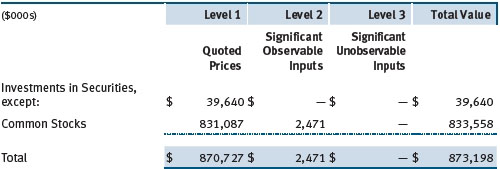
There were no material transfers between Levels 1 and 2 during the six months ended June 30, 2014.
NOTE 3 - OTHER INVESTMENT TRANSACTIONS
Consistent with its investment objective, the fund engages in the following practices to manage exposure to certain risks and/or to enhance performance. The investment objective, policies, program, and risk factors of the fund are described more fully in the fund’s prospectus and Statement of Additional Information.
Securities Lending The fund may lend its securities to approved brokers to earn additional income. Its securities lending activities are administered by a lending agent in accordance with a securities lending agreement. It receives collateral in the form of cash or U.S. government securities, valued at 102% to 105% of the value of the securities on loan. Collateral is maintained over the life of the loan in an amount not less than the value of loaned securities; any additional collateral required due to changes in security values is delivered to the fund the next business day. Cash collateral is invested by the lending agent(s) in accordance with investment guidelines approved by fund management. Additionally, the lending agent indemnifies the fund against losses resulting from borrower default. Although risk is mitigated by the collateral and indemnification, the fund could experience a delay in recovering its securities and a possible loss of income or value if the borrower fails to return the securities, collateral investments decline in value and the lending agent fails to perform. Securities lending revenue consists of earnings on invested collateral and borrowing fees, net of any rebates to the borrower, compensation to the lending agent, and other administrative costs. In accordance with GAAP, investments made with cash collateral are reflected in the accompanying financial statements, but collateral received in the form of securities is not. At June 30, 2014, the value of loaned securities was $31,732,000; the value of cash collateral and related investments was $32,504,000.
Other Purchases and sales of portfolio securities other than short-term securities aggregated $113,263,000 and $66,782,000, respectively, for the six months ended June 30, 2014.
NOTE 4 - FEDERAL INCOME TAXES
No provision for federal income taxes is required since the fund intends to continue to qualify as a regulated investment company under Subchapter M of the Internal Revenue Code and distribute to shareholders all of its taxable income and gains. Distributions determined in accordance with federal income tax regulations may differ in amount or character from net investment income and realized gains for financial reporting purposes. Financial reporting records are adjusted for permanent book/tax differences to reflect tax character but are not adjusted for temporary differences. The amount and character of tax-basis distributions and composition of net assets are finalized at fiscal year-end; accordingly, tax-basis balances have not been determined as of the date of this report.
At June 30, 2014, the cost of investments for federal income tax purposes was $622,375,000. Net unrealized gain aggregated $250,823,000 at period-end, of which $262,400,000 related to appreciated investments and $11,577,000 related to depreciated investments.
NOTE 5 - RELATED PARTY TRANSACTIONS
The fund is managed by T. Rowe Price Associates, Inc. (Price Associates), a wholly owned subsidiary of T. Rowe Price Group, Inc. (Price Group). The investment management agreement between the fund and Price Associates provides for an annual investment management fee, which is computed daily and paid monthly. The fee consists of an individual fund fee, equal to 0.35% of the fund’s average daily net assets, and a group fee. The group fee rate is calculated based on the combined net assets of certain mutual funds sponsored by Price Associates (the group) applied to a graduated fee schedule, with rates ranging from 0.48% for the first $1 billion of assets to 0.275% for assets in excess of $400 billion. The fund’s group fee is determined by applying the group fee rate to the fund’s average daily net assets. At June 30, 2014, the effective annual group fee rate was 0.29%.
In addition, the fund has entered into service agreements with Price Associates and two wholly owned subsidiaries of Price Associates (collectively, Price). Price Associates computes the daily share price and provides certain other administrative services to the fund. T. Rowe Price Services, Inc., provides shareholder and administrative services in its capacity as the fund’s transfer and dividend-disbursing agent. T. Rowe Price Retirement Plan Services, Inc., provides subaccounting and recordkeeping services for certain retirement accounts invested in the fund. For the six months ended June 30, 2014, expenses incurred pursuant to these service agreements were $47,000 for Price Associates; $241,000 for T. Rowe Price Services, Inc.; and $22,000 for T. Rowe Price Retirement Plan Services, Inc. The total amount payable at period-end pursuant to these service agreements is reflected as Due to Affiliates in the accompanying financial statements.
The fund may invest in the T. Rowe Price Reserve Investment Fund, the T. Rowe Price Government Reserve Investment Fund, or the T. Rowe Price Short-Term Reserve Fund (collectively, the Price Reserve Investment Funds), open-end management investment companies managed by Price Associates and considered affiliates of the fund. The Price Reserve Investment Funds are offered as short-term investment options to mutual funds, trusts, and other accounts managed by Price Associates or its affiliates and are not available for direct purchase by members of the public. The Price Reserve Investment Funds pay no investment management fees.
| Information on Proxy Voting Policies, Procedures, and Records |
A description of the policies and procedures used by T. Rowe Price funds and portfolios to determine how to vote proxies relating to portfolio securities is available in each fund’s Statement of Additional Information. You may request this document by calling 1-800-225-5132 or by accessing the SEC’s website, sec.gov.
The description of our proxy voting policies and procedures is also available on our website, troweprice.com. To access it, click on the words “Social Responsibility” at the top of our corporate homepage. Next, click on the words “Conducting Business Responsibly” on the left side of the page that appears. Finally, click on the words “Proxy Voting Policies” on the left side of the page that appears.
Each fund’s most recent annual proxy voting record is available on our website and through the SEC’s website. To access it through our website, follow the above directions to reach the “Conducting Business Responsibly” page. Click on the words “Proxy Voting Records” on the left side of that page, and then click on the “View Proxy Voting Records” link at the bottom of the page that appears.
| How to Obtain Quarterly Portfolio Holdings |
The fund files a complete schedule of portfolio holdings with the Securities and Exchange Commission for the first and third quarters of each fiscal year on Form N-Q. The fund’s Form N-Q is available electronically on the SEC’s website (sec.gov); hard copies may be reviewed and copied at the SEC’s Public Reference Room, 100 F St. N.E., Washington, DC 20549. For more information on the Public Reference Room, call 1-800-SEC-0330.
| Approval of Investment Management Agreement |
On April 30, 2014, the fund’s Board of Directors (Board), including a majority of the fund’s independent directors, approved the continuation of the investment management agreement (Advisory Contract) between the fund and its investment advisor, T. Rowe Price Associates, Inc. (Advisor). The April meeting followed a telephonic meeting held on March 4, 2014, during which the Board reviewed information and discussed the continuation of the Advisory Contract. In connection with its deliberations, the Board requested, and the Advisor provided, such information as the Board (with advice from independent legal counsel) deemed reasonably necessary. The Board considered a variety of factors in connection with its review of the Advisory Contract, also taking into account information provided by the Advisor during the course of the year, as discussed below:
Services Provided by the Advisor
The Board considered the nature, quality, and extent of the services provided to the fund by the Advisor. These services included, but were not limited to, directing the fund’s investments in accordance with its investment program and the overall management of the fund’s portfolio, as well as a variety of related activities such as financial, investment operations, and administrative services; compliance; maintaining the fund’s records and registrations; and shareholder communications. The Board also reviewed the background and experience of the Advisor’s senior management team and investment personnel involved in the management of the fund, as well as the Advisor’s compliance record. The Board concluded that it was satisfied with the nature, quality, and extent of the services provided by the Advisor.
Investment Performance of the Fund
The Board reviewed the fund’s three-month, one-year, and year-by-year returns, as well as the fund’s average annualized total returns over the 3-, 5-, and 10-year periods, and compared these returns with a wide variety of previously agreed upon comparable performance measures and market data, including those supplied by Lipper and Morningstar, which are independent providers of mutual fund data.
On the basis of this evaluation and the Board’s ongoing review of investment results, and factoring in the relative market conditions during certain of the performance periods, the Board concluded that the fund’s performance was satisfactory.
Costs, Benefits, Profits, and Economies of Scale
The Board reviewed detailed information regarding the revenues received by the Advisor under the Advisory Contract and other benefits that the Advisor (and its affiliates) may have realized from its relationship with the fund, including any research received under “soft dollar” agreements and commission-sharing arrangements with broker-dealers. The Board considered that the Advisor may receive some benefit from soft-dollar arrangements pursuant to which research is received from broker-dealers that execute the applicable fund’s portfolio transactions. The Board received information on the estimated costs incurred and profits realized by the Advisor from managing T. Rowe Price mutual funds.
The Board also reviewed estimates of the profits realized from managing the fund in particular, and the Board concluded that the Advisor’s profits were reasonable in light of the services provided to the fund.
The Board also considered whether the fund benefits under the fee levels set forth in the Advisory Contract from any economies of scale realized by the Advisor. Under the Advisory Contract, the fund pays a fee to the Advisor for investment management services composed of two components—a group fee rate based on the combined average net assets of most of the T. Rowe Price mutual funds (including the fund) that declines at certain asset levels and an individual fund fee rate based on the fund’s average daily net assets—and the fund pays its own expenses of operations. The Board concluded that the advisory fee structure for the fund continued to provide for a reasonable sharing of benefits from any economies of scale with the fund’s investors.
Fees
The Board was provided with information regarding industry trends in management fees and expenses, and the Board reviewed the fund’s management fee rate, operating expenses, and total expense ratio in comparison with fees and expenses of other comparable funds based on information and data supplied by Lipper. The information provided to the Board indicated that the fund’s management fee rate and total expense ratio were at or below the median for comparable funds.
The Board also reviewed the fee schedules for institutional accounts and private accounts with similar mandates that are advised or subadvised by the Advisor and its affiliates. Management provided the Board with information about the Advisor’s responsibilities and services provided to institutional account clients, including information about how the requirements and economics of the institutional business are fundamentally different from those of the mutual fund business. The Board considered information showing that the mutual fund business is generally more complex from a business and compliance perspective than the institutional business and that the Advisor generally performs significant additional services and assumes greater risk in managing the fund and other T. Rowe Price mutual funds than it does for institutional account clients.
On the basis of the information provided and the factors considered, the Board concluded that the fees paid by the fund under the Advisory Contract are reasonable.
Approval of the Advisory Contract
As noted, the Board approved the continuation of the Advisory Contract. No single factor was considered in isolation or to be determinative to the decision. Rather, the Board concluded, in light of a weighting and balancing of all factors considered, that it was in the best interests of the fund and its shareholders for the Board to approve the continuation of the Advisory Contract (including the fees to be charged for services thereunder). The independent directors were advised throughout the process by independent legal counsel.
Item 2. Code of Ethics.
A code of ethics, as defined in Item 2 of Form N-CSR, applicable to its principal executive officer, principal financial officer, principal accounting officer or controller, or persons performing similar functions is filed as an exhibit to the registrant’s annual Form N-CSR. No substantive amendments were approved or waivers were granted to this code of ethics during the registrant’s most recent fiscal half-year.
Item 3. Audit Committee Financial Expert.
Disclosure required in registrant’s annual Form N-CSR.
Item 4. Principal Accountant Fees and Services.
Disclosure required in registrant’s annual Form N-CSR.
Item 5. Audit Committee of Listed Registrants.
Not applicable.
Item 6. Investments.
(a) Not applicable. The complete schedule of investments is included in Item 1 of this Form N-CSR.
(b) Not applicable.
Item 7. Disclosure of Proxy Voting Policies and Procedures for Closed-End Management Investment Companies.
Not applicable.
Item 8. Portfolio Managers of Closed-End Management Investment Companies.
Not applicable.
Item 9. Purchases of Equity Securities by Closed-End Management Investment Company and Affiliated Purchasers.
Not applicable.
Item 10. Submission of Matters to a Vote of Security Holders.
Not applicable.
Item 11. Controls and Procedures.
(a) The registrant’s principal executive officer and principal financial officer have evaluated the registrant’s disclosure controls and procedures within 90 days of this filing and have concluded that the registrant’s disclosure controls and procedures were effective, as of that date, in ensuring that information required to be disclosed by the registrant in this Form N-CSR was recorded, processed, summarized, and reported timely.
(b) The registrant’s principal executive officer and principal financial officer are aware of no change in the registrant’s internal control over financial reporting that occurred during the registrant’s second fiscal quarter covered by this report that has materially affected, or is reasonably likely to materially affect, the registrant’s internal control over financial reporting.
Item 12. Exhibits.
(a)(1) The registrant’s code of ethics pursuant to Item 2 of Form N-CSR is filed with the registrant’s annual Form N-CSR.
(2) Separate certifications by the registrant's principal executive officer and principal financial officer, pursuant to Section 302 of the Sarbanes-Oxley Act of 2002 and required by Rule 30a-2(a) under the Investment Company Act of 1940, are attached.
(3) Written solicitation to repurchase securities issued by closed-end companies: not applicable.
(b) A certification by the registrant's principal executive officer and principal financial officer, pursuant to Section 906 of the Sarbanes-Oxley Act of 2002 and required by Rule 30a-2(b) under the Investment Company Act of 1940, is attached.
SIGNATURES
Pursuant to the requirements of the Securities Exchange Act of 1934 and the Investment Company Act of 1940, the registrant has duly caused this report to be signed on its behalf by the undersigned, thereunto duly authorized.
T. Rowe Price Diversified Small-Cap Growth Fund, Inc.
| By | /s/ Edward C. Bernard | |
| Edward C. Bernard | ||
| Principal Executive Officer | ||
| Date August 18, 2014 | ||
Pursuant to the requirements of the Securities Exchange Act of 1934 and the Investment Company Act of 1940, this report has been signed below by the following persons on behalf of the registrant and in the capacities and on the dates indicated.
| By | /s/ Edward C. Bernard | |
| Edward C. Bernard | ||
| Principal Executive Officer | ||
| Date August 18, 2014 | ||
| By | /s/ Gregory K. Hinkle | |
| Gregory K. Hinkle | ||
| Principal Financial Officer | ||
| Date August 18, 2014 | ||